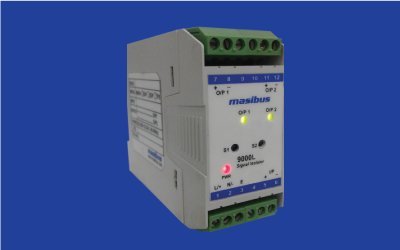
Isolators FAQ
For any product or application related question just type here ?
Isolators
- Isolation can prevent the transfer of high or hazardous voltages between circuits
- Isolation can do the protection from electric shocks
- It can reject high common-mode voltages
- Isolation can break the conduction path for high transient voltage noise between circuits, like voltage spikes that are generated from switching inductive loads, lightning, etc.
- It can break potential ground loops, in an electric circuit, a potential difference or the voltage is the force that will drive current flow through it
Signal converters are used to convert one type of signal (mA/mV/V) to a standard 4-20mA or some other signal type that is compatible with a particular receiving device.
Short circuit protection is very important for the work concerned in any field, as there are many chances for small or heavy damage to occur, if protection is not provided. Isolators come up to 2 outputs with short circuit protection. TPS output maximum current limit is 26mA.
- If red LED at the front side is not turned “ON”, the device is not getting sufficient supply or the connections are not as per terminal details
- Make sure the load on output of the device is as per specification criteria
- Make sure the output signal is really incorrect with respect to the input signal before attempting any re-calibration
- Check for loose connections
- Verify that all conventional instrumentation norms have been followed for wiring
- Keep electromagnetic noise away from signal isolators
- The input and output ranges for switch selection isolator are 0/4 to 20mA, 0/1 to 5V, 0 to 10VDC
- In the dual output model, you can configure both output types differently also. It is not mandatory to keep the same types in both outputs
- If the overload at output, output current will be reduced
Transmitters
- Is the connection as per polarity?
- Check the connection diagram from the operational manual D+ and D-
- Is the modbus parameter for serial communication configured properly?
- Check the serial No. and baud rate settings at master device and slave device
- Thermocouple temperature sensors are constructed using two dissimilar metals that are joined together. The junctions are called the measuring junction and the reference junction (output terminal side). A thermo electromotive force is generated between the junctions with a fixed correlation to the temperature providing the difference in temperature
- Therefore, the temperature at the measuring junction can be determined from the thermo electromotive force when a fixed temperature is maintained at the reference junction
- Thermocouple temperature sensors are capable of measuring the highest temperatures among contact temperature sensors by using this measurement method.
- RTD-PT100 Sensor
All three lead wires used for extension must have the same resistance and the same length. The extension will cause the resistance of the lead wires to affect the display temperature, so use lead wires with thick conductors. (OMRON does not carry lead wires for extension. Use commercially available lead wires)
- Thermocouples
Be sure to use compensating conductors for the extension. Also, select compensating conductors that suit the characteristics of the Thermocouple. Do not extend the lead wires with compensating conductors that do not suit the characteristics of the Thermocouple, or with ordinary lead wires, as this would prevent proper temperature measurement. Be sure also to connect the wires using the correct polarity (+/-)
- Transmitters input/output parameters are user configurable
- User can easily configure it by using “mTRAN”
- It is a windows based software used for configuring, calibration and monitoring the transmitters
- If you forget the password for the device then use master password to enter in the modes. Take a master password from the Masibus customer support. email: [email protected]
- When plugged into an outlet wired incorrectly, reverse polarity can easily damage the instruments. Reverse polarity protection is an internal circuit that ensures that the device is not damaged if the power supply polarity is reversed. Masibus transmitters are compatible with reverse polarity protection
- Yes, users can configure the direct/reverse output current/voltage using mTRAN software
- Offset parameter is used to nullify the dead weight i.e. base plate weight to have an actual measurement of material weight measurement. Once the user enters the indicated bare weight into an offset parameter, the device will automatically nullify the weight of the bare plate for an actual measurement. By this, the user can measure the actual weight by avoiding the dead weight value of base plate
- It is a normal fact that increase in load leads to decrease in the supply voltage. Hence the voltage supplied by the transformer to the load must be maintained within the prescribed limits. This can be done by changing the transformer turns ratio
- The taps are leads or connections provided at various points on the winding. The turns ratio differs from one tap to another and hence different voltages can be obtained at each tap


